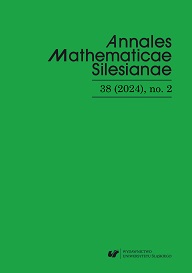W. Bergweiler and J.K. Langley, Zeros of differences of meromorphic functions, Math. Proc. Cambridge Philos. Soc. 142 (2007), no. 1, 133–147.
Google Scholar
Y.-M. Chiang and S.-J. Feng, On the Nevanlinna characteristic of f(z + η) and difference equations in the complex plane, Ramanujan J. 16 (2008), no. 1, 105–129.
Google Scholar
F. Gross, On the equation f^n + g^n = 1, Bull. Amer. Math. Soc. 72 (1966), 86–88.
Google Scholar
F. Gross, On the functional equation f^n +g^n = h^n, Amer. Math. Monthly 73 (1966), no. 10, 1093–1096.
Google Scholar
F. Gross, On the equation f^n + g^n = 1. II, Bull. Amer. Math. Soc. 74 (1968), no. 4, 647–648.
Google Scholar
F. Gross, Factorization of Meromorphic Functions, Mathematics Research Center, Naval Research Laboratory, Washington, DC, 1972.
Google Scholar
R.G. Halburd and R.J. Korhonen, Difference analogue of the lemma on the logarithmic derivative with applications to difference equations, J. Math. Anal. Appl. 314 (2006), no. 2, 477–487.
Google Scholar
W.K. Hayman, Meromorphic Functions, Clarendon Press, Oxford, 1964.
Google Scholar
P.-C. Hu and C.-C. Yang, Uniqueness of meromorphic functions on ℂ^m, Complex Variables Theory Appl. 30 (1996), no. 3, 235–270.
Google Scholar
K. Liu, I. Laine, L. Yang, Complex Delay-Differential Equations, De Gruyter, Berlin, 2021.
Google Scholar
K. Liu, L. Ma, and X. Zhai, The generalized Fermat type difference equations, Bull. Korean Math. Soc. 55 (2018), no. 6, 1845–1858.
Google Scholar
K. Liu and L. Yang, On entire solutions of some differential-difference equations, Comput. Methods Funct. Theory 13 (2013), no. 3, 433–447.
Google Scholar
K. Liu and L. Yang, A note on meromorphic solutions of Fermat types equations, An. Ştiinţ. Univ. Al. I. Cuza Iaşi. Mat. (N.S.) 62, vol. 1 (2016), no. 2, 317–325.
Google Scholar
E.G. Saleeby, On complex analytic solutions of certain trinomial functional and partial differential equations, Aequationes Math. 85 (2013), no. 3, 553–562.
Google Scholar
W. Stoll, Holomorphic Functions of Finite Order in Several Complex Variables, Amer. Math. Soc., Providence, RI, 1974.
Google Scholar
A.J. Wiles, Modular elliptic curves and Fermat’s last theorem, Ann. of Math. (2) 141 (1995), no. 3, 443–551.
Google Scholar
C.-C. Yang and H.-X. Yi, Uniqueness Theory of Meromorphic Functions, Science Press, Beijing/New York, 2003.
Google Scholar
Z. Ye, On Nevanlinna’s second main theorem in projective space, Invent. Math. 122 (1995), no. 3, 475–507.
Google Scholar
M. Zhang, J. Xiao, and M. Fang, Entire solutions for several Fermat type differential difference equations, AIMS Math. 7 (2022), no. 7, 11597–11613.
Google Scholar



 10.2478/amsil
10.2478/amsil